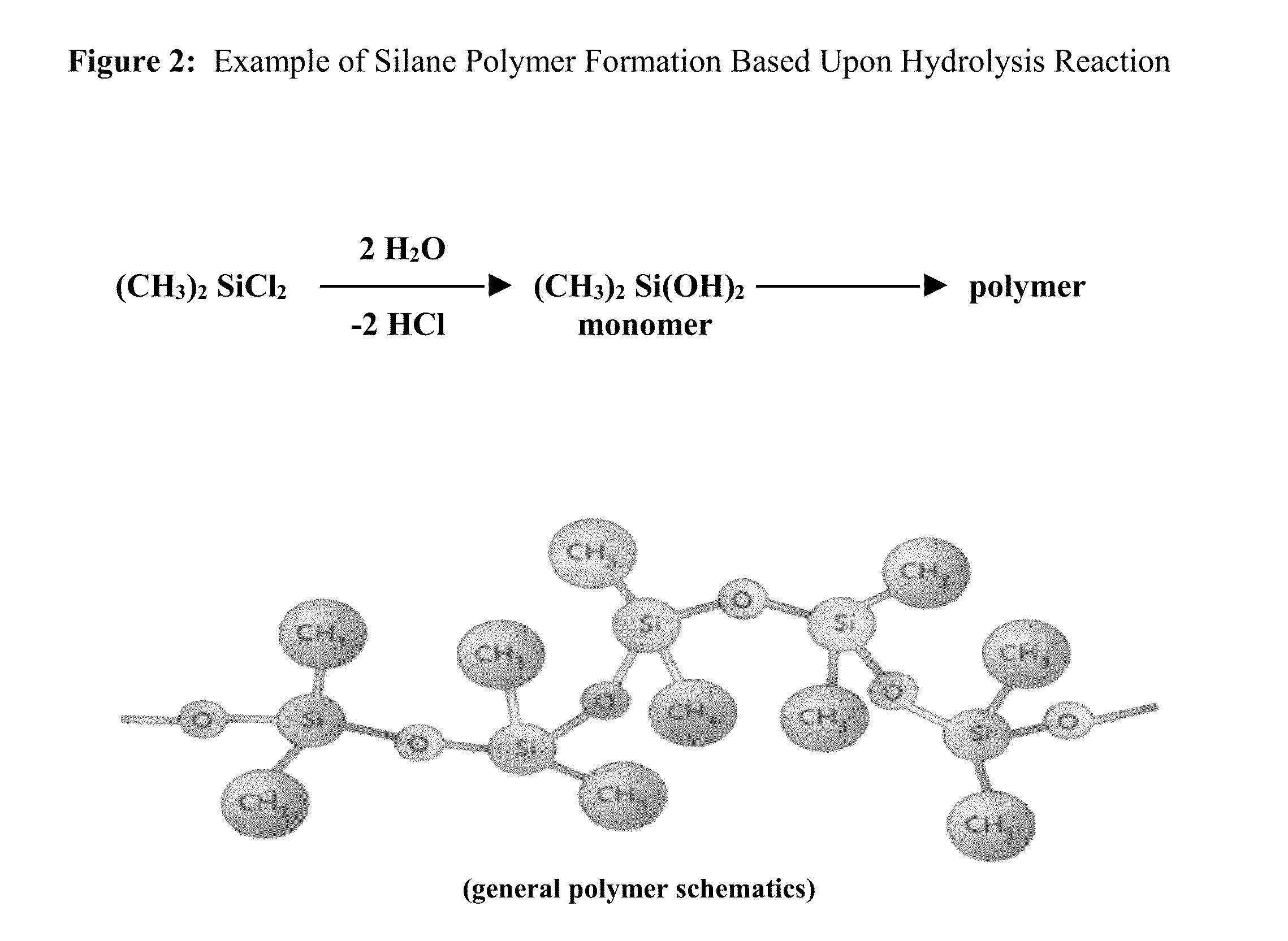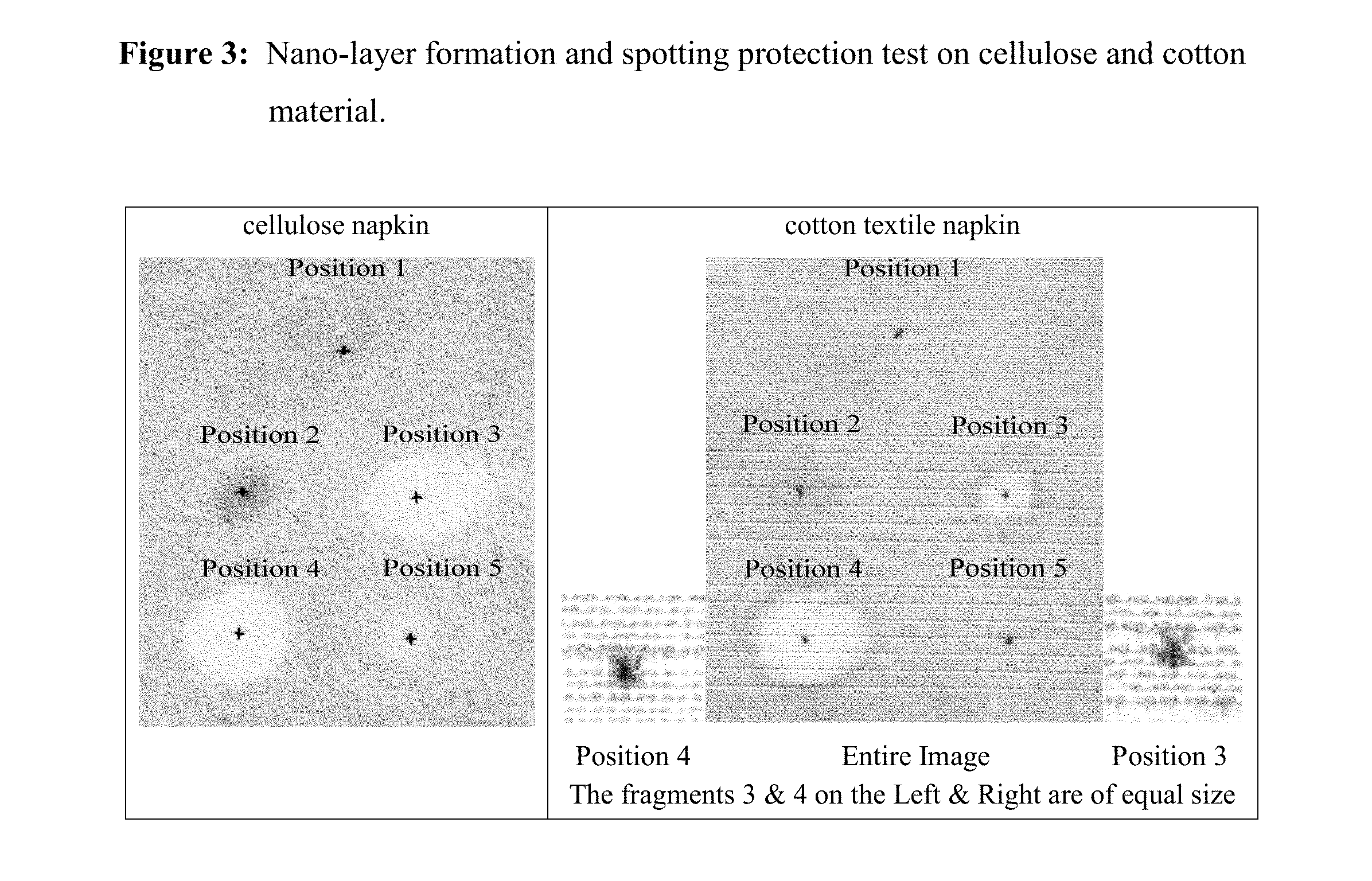Method and substrate for covalent attachment and encapsulation of biological, chemical and physical substances
- Summary
- Abstract
- Description
- Claims
- Application Information
AI Technical Summary
Benefits of technology
Problems solved by technology
Method used
Image
Examples
experiment-1
[0039]Test Conditions Specified amounts of silanes' solution mixtures (from the bottled solutions as numbered above) were center-spotted in the amounts specified below on a white cellulose paper napkin and on white cotton napkin at the positions specified below (image). A 20-μl Gilson automatic pipetter was used for the deposition of the mixtures. Spotted materials were dried for 20 min at 40° C. and then were completely soaked (immersed) for 30 minutes in a methylene blue / xylene cyanol dye solution in water. Then the dye-solution excess was removed by gently pressing the wet material between a paper-towel for 3 sec. and then air-drying for 30 min at 40° C. Black carbon-pencil mark (“+”) shows the center of the spotting (FIG. 3). The large white spots represent the water-repellent protected areas. Images were taken at 600 dpi on Canon LIDE-20 scanner.
Prepared Solutions:
[0040]
Solution #1:100% Decamethylcyclopentasiloxane [from Oakwood Chemical; Catalog #: S05475]Solution #2:90 ml of ...
experiment-1 conclusions
[0041]The experimental result (FIG. 3) clearly evidences that the ability of tri-chloro silanes to create 3-dimensional nano-layers produces a better water-repellant coating and better encapsulation efficiency (positions 2 and 3), successfully entrapping even the large-size (sub-millimeter) spaces existing within the cotton napkin, when compared to the 2-dimensional nano-layer created by the di-chloro silanes (positions 1 and 4 on FIG. 3)—in this experiment all chemically-reactive silanes were cross-combined with the chemically “passive” cyclosilane (decamethylcyclopentasiloxane).
[0042]Comparing positions 2 and 3 shows the significant influence of the hydrophobic hydrocarbon chain on the water-repellant properties—i.e. the longer the chain is (position 3) the better the water-repellant protection is. This is better visible and distinguished when the air-gaps between the material support are larger (cotton napkin; right-image) compared to the smaller gaps (cellulose napkin; left-imag...
experiment 2
[0043]Encapsulation of HL-60 human lymphocyte cells followed by fluorescent hybridization (FIG. 4). Thrimethyliodosilane was used as 1% solution in tholuol for both cell entrapment onto glass slide and for fixing the cell-content including the nucleic acids inside. Both the fixation entrapment and the cell-content fixation sere instant upon contact with the silane solution thereby serving as a perfect preservation method. In situ hybridization on HL-60 human lymphocyte cells stimulated by 10 ng / ml phorbylmyristate acetate (PMA) mounted on glass slide. The hybridization probe was 541-bp PCR fluorescein-dUTP-labeled cDNA fragment of GMC-SF receptor mRNA. White areas (FIG. 5) correspond to the presence of GMC-SF receptor transcript. The silane-mediated entrapment had ensured 100% retention rate, perfect content preservation, perfect chemical and biochemical permeability and ability to store and preserve the material for decades; in our case the material was still present in unmodified ...
PUM
| Property | Measurement | Unit |
|---|---|---|
| Temperature | aaaaa | aaaaa |
| Temperature | aaaaa | aaaaa |
| Temperature | aaaaa | aaaaa |
Abstract
Description
Claims
Application Information
 Login to View More
Login to View More - Generate Ideas
- Intellectual Property
- Life Sciences
- Materials
- Tech Scout
- Unparalleled Data Quality
- Higher Quality Content
- 60% Fewer Hallucinations
Browse by: Latest US Patents, China's latest patents, Technical Efficacy Thesaurus, Application Domain, Technology Topic, Popular Technical Reports.
© 2025 PatSnap. All rights reserved.Legal|Privacy policy|Modern Slavery Act Transparency Statement|Sitemap|About US| Contact US: help@patsnap.com



